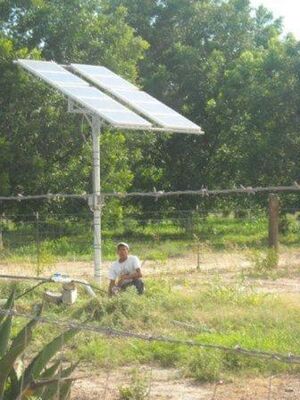
This page contains information on different uses of solar energy studied in the Parras 2006 program.
Solar clothes dryer[edit | edit source]
- Description
- Uses the suns heat to dry wet clothes
- Justification
- It is a free, easy to use, local and effective way of drying clothes
- Issues
- Cannot be used at night. It is weather sensitive
Solar Panel[edit | edit source]
- Description
- Photovoltaic cells that convert the sun's energy into electricity
- Location
- Parras Cone fabric factory off of 16 de Septiembre
- Justification
- Sunlight is abundant in almost every corner of the earth. Over the life of a PV, not only does the panel pay for itself many times over, but it also reduces the consumption of fossil fuels as an alternative method of energy generation.
- Issues
- PV cells are expensive, require some degree of knowledge to maintain if broken, and the manufacturing of cells produces some harmful byproducts.
Solar Energy Use in Houses[edit | edit source]
- Description
- In many Mexican houses it is customary to have a common space where the family relaxes before and after work and meals that is generally a courtyard and patio since there weather is generally dry for most of the year. The fact that the courtyard is open in the sun gives the space more purposes than relaxation. In the pictures below you can see that fruit trees are harvested within the house borders, making use of the solar energy that is predominate in the Mexican climate. The courtyard also keeps the house warm in the winter, since all the trees loose there leaves and expose the rest of the house to the sun. The trees in the courtyard keep the house cool in the summer, absorbing the solar energy before it heats up the rest of the house to uncomfortable temperatures.
- Location
- The courtyard is located centrally within the house, in many Mexican residences.
- Justification as Appropriate
- It is an example of appropriate technology because it makes use of the natural environment. It has many functions for one area in the house. It reduces the amount of added energy needed to maintain a comfortable temperature in the household. The family becomes more self sufficient because they are harvesting their own fruits.
- Issues with the Appropriateness
When it rains, the water runs into the street. This is a wasteful management of water.
Solar Powered Irrigation Pump[edit | edit source]
- Description
- A local nogalero (pecan farmer) is taking advantage of the plentiful sunlight in Parras and converting it into renewable, clean and local energy to pump water for his huerta (orchard).
- Location
- If you take Ramos Arispe east from the semaforo (stoplight) by the fabrica Estrella, and keep going strait for a bit (less than 15 minutes by car), you`ll see an orchard to the left with a well-developed gravel driveway. Drive down about 5 minutes and you`ll see the panel on the right.
- Justification as Appropriate
- The 2008 Parras group listed Ecologically Sound as a definition of AT. This solar panel fits the definition in two ways: first, the alternative solar energy reduces the demand on the coal-powered electricity plant near Saltillo that provides power to Parras, reducing the ecological damage of burning coal. Second, and more indirectly, the pump provides pressure to the irrigation system which the farmer is using in place of the traditional flooding method. While we hesitate to change long-standing work methods, the farmers here see pressurized irrigation systems as better, because it uses less water, and is distributed evenly across the orchard, assuring a better harvest.
- Issues with the Appropriateness
- The farmer said that he was using electricity rather than the solar panel at the time, because the weather had been cloudy. If he had been solely dependent on solar energy he would have not been able to irrigate when he needed to.



